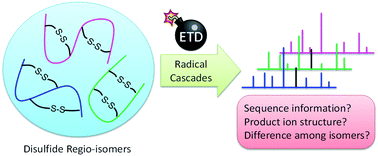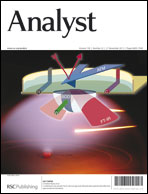Radical cascades in electron transfer dissociation (ETD) – implications for characterizing peptide disulfide regio-isomers†
Abstract
Direct characterization of peptides with multiple disulfide bonds by mass spectrometry is highly desirable. In this study, electron transfer dissociation (ETD) of peptide disulfide regio-isomers was studied using model peptides containing two intrachain disulfide bonds. ETD provided rich sequence information (c/z ions) even for the backbone region under the coverage of two disulfide bonds. This behavior presented an analytical advantage over low energy collision-induced dissociation (CID) of protonated intact peptide ions, which produced very limited sequence (b/y) ions. Mechanistic studies suggested that the formation of c/z ions under the two disulfide bond covered region resulted from an initial N–Cα bond cleavage, followed by radical cascades to cleave multiple disulfide bonds. The ETD spectra of the disulfide regio-isomers produced similar product ions due to radical cascades; while the relative intensities of the product ions varied, to a certain degree, which could be helpful in distinguishing isomers with overlapping disulfide bonds.


 Please wait while we load your content...
Please wait while we load your content...